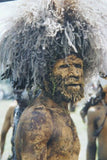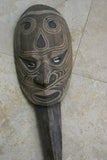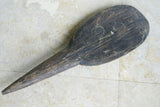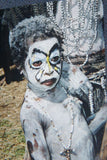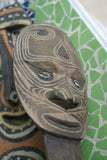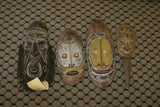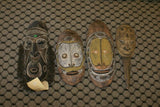Original Iatmul Hand carved Polychrome Big Man Debate Dagger Sepik Papua Guinea
Item 12A7 in our inventory
(Seen on most of the photos)
Collected in the field 20+ years ago
Measures: 18"x 6"
Original, Iatmul hand-carved hand-painted with natural pigments
Polychrome Big Man Debate Dagger with nassa shells eyes
From Sepik river, Papua New Guinea
THIS IS A LIQUIDATION AT REDUCED PRICE, WE CLOSED OUR ACTUAL STORE DOORS
Iatmul tribe Detailed Magic Dagger Mask, Korogo village, Sepik region, PNG
(Papua New Guinea)
Ceremonial daggers are never used as a weapon although some people refer to them as such. These daggers are used to control debates that are not in the Haus Tambaran, and sometimes in dances. The legend has it that depending on who you ask the dagger either moves through the ground or turns to face the man with the "strongest talk" and this man has his say until the dagger chooses someone else. Actually what happens is that the dagger is pushed into ground in front of the man who is about to talk. As in the Haus Tambaran, quite often, there is a background level of discussion, the power coming from this object gives the speaker the confidence to talk above everyone else. Such instruments also have a power as payback tools.
The Iatmul payback or ceremonial bone or wood daggers have clay or wood carved heads painted with clan designs. In the case of a payback use, the face represents the person to be avenged in the payback or wantok ceremony. The payback account is usually settled with the killing of an animal or a bird or in the past, a man. Mask above bears clan motifs which are similar to the designs painted on the participants' faces during ceremonies.
Masks, statues and carvings of Papua New Guinea’s cultures serve a variety of spiritual, cultural and decorative purposes. Most of the carvings found in PNG are from the Sepik region, where the production and use of masks, among other things, is an important part of traditional culture. Ancestral masks, for example, represent deceased clan ancestors, totemic creatures that assist the tribe by interceding on a high plane to provide food, prevent and cure illness, while spirit masks embody tribal spirits who inhabit the surrounding jungle, & may come to the help of the tribe to counterattack sorcery spells meant to arm them.
Ancestors assist one's life by interceding on a high plane to provide food, prevent and cure illness, acquire stature, and counter sorcery attempted via the ancestor spirit plane. These are examples of beautiful rare original standing masks of Ancestral figures from Papua New Guinea (above and next page): hand-carved wood adorned with rattan basketry, cassowary feathers and hand-painted with clay-based colors, shell eyes & clan animal at the top.
If a village or clan has a lot of bad luck, the whole group may change their names and buy the rights to use masks from another clan in a different village in an attempt to fool the bad spirits or sorcerers. The resulting masks usually display characteristics of both groups. Each Sepik River village otherwise is independent and has a distinctive style. No two masks can ever be exactly the same either. Each is crafted by a different artist, representing a different ancestor or spirit, and is therefore unique. (As a matter of fact, copying is forbidden and sentenced by local law unless there is a formal agreement between the parties involved.)
The men carve masks from indigenous wood. Paint is made from earth pigments and charcoal. Masks can be decorated with shells, pig tusks, and Cassowary feathers. Few masks are worn directly over the face, which explains why many lack holes for eyes. They may be part of a large cone-shaped wicker framework for a dance costume called a tumbuan. Other masks are made only for display in the men's Haus to attract powerful and useful spirits. Masks often refer to a clan totem such as crocodile or eagle usually represented carved on the forehead. New masks may appear when a man dreams a spirit and carves a mask to represent it.
Check Dominique Rice Oceania Store in Sun Sentinel Newspaper, Fort Lauderdale, for information on our collection and authentic art.
All our collector and rare items come with pages and pages of research about provenance, and with history of the tribes and photos as well, depending on item and whenever possible. When shipping internationally, we group ship multiple purchases to save you money, and find the best rates available. If you have any questions or want to see research conducted on this piece and photos of tribes, let us know.
We have artifacts and architectural accents up to 10 ft tall that we will put on upon request because shipping has to be calculated accordingly with trucking company.













